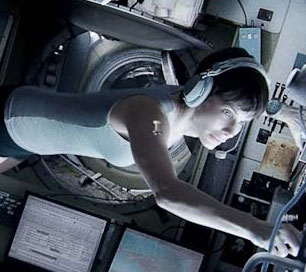 One of the most buzzed about films of this year’s Toronto International Film Festival would have to be Gravity. Just the sheer accomplishment of getting into a screening is flaunted like a badge of honour among press and public as though they themselves have become one of the world’s first space tourists. But why all the hype over a film that’s essentially Sandra Bullock and George Clooney’s heads floating in goldfish bowls for an hour and a half?
One of the most buzzed about films of this year’s Toronto International Film Festival would have to be Gravity. Just the sheer accomplishment of getting into a screening is flaunted like a badge of honour among press and public as though they themselves have become one of the world’s first space tourists. But why all the hype over a film that’s essentially Sandra Bullock and George Clooney’s heads floating in goldfish bowls for an hour and a half?
Gravity seemingly hits that sweet spot between artsy festival fare, visual effects trailblazer and star-driven popcorn pleaser. The script is simple, a trite “lost in space” adventure, but the backstory behind the production is what makes the film all that more remarkable. As Sandra Bullock comments during our roundtable interview session, “We just need to make another movie on how we made this movie.”
Sitting pretty alongside director Alfonso Cuarón, it’s almost impossible to imagine the petite Bullock enduring a laborious 10 hour long session strung up on a 12-wire rig like a human marionette. But that she did, helped by the very puppeteers behind War Horse, all in a bid to replicate zero-gravity and satisfy Cuarón’s penchant for long, fluid shots.
“There was some blood and blisters, but you know there were contraptions that took at least 20 minutes to get into,” says Bullock in an animated manner of talking with her hands. “It harnessed and locked you into something that you had no control of once it started. I was always strapped down… and there’d be a blister coming or something cutting into your leg.”
“But the gruesomeness is in defence of the process!” adds Cuarón rather excitedly. As the visionary behind Gravity’s trippy ride – indeed a ride that can only be compared to an Epcot Imax experience – Cuarón came to the project with a deep fascination of space and exploration. But for all his survival ideology and story set in the final frontier, there was little he could offer by way of pitching how the mission would be accomplished.
“It’s such a strangely intimate profession and I had such star envy of this one,” says Bullock as she gestures to Cuarón. “I was like ‘Wow, I don’t know how this is going to work. What do I have to offer? But he knew in his head what he wanted and what he wanted to say with this. I was Houston in the blind! I was like ‘Alfonso in the blind, again! I just want you to remind me of what I’m looking at, what’s happening here!’ Because it was blind and the studio was going into it blindly.”
As Cuarón and Bullock explain, when the studio execs, “the suits,” came calling on set, there was scarce material by which they could validate their splurged dollars (all 80 million of them). In the past, most space adventures have utilised the old “vomit comet,” a plane that climbs and plummets to cause momentary weightlessness, but this technique was quickly eliminated by Cuarón in favour of the new wire system. But why redesign the wheel?
“I have to say, every single day I ask that same question, but the truth of the matter is that Sandra trained so much and rehearsed so much that, when we were shooting, we rarely discussed the technical aspect of it. Most of the time we were just talking about performance and emotion,” says Cuarón.
And therein lies the other dimension of Gravity: The emotive element in which Bullock commands the screen in elongated shots of her fighting for her life.
“Every actor will tell you that they’re always panicked about trying to convey emotion with the least amount of crutches,” says Bullock about telling a story through an astronaut’s helmet. “If all you have are your eyes or your face, you just need to feel it truthfully. But I didn’t ever think ‘Oh I’m behind a visor,’ because to me it was still my whole body feeling and being there. Then again there were a lot of times when I thought I was emoting something and they’d be like ‘Huh, we didn’t see it!’ I just had to trust in what [Cuarón] saw. I saw nothing, I heard nothing, just these lights and blackness everywhere.”
“Probably the longest shot of the whole film is pure performance,” says Cuarón. “It’s the longest shot of Sandra inside a capsule that begins from the moment she lost faith, she talks to the radio, George enters the whole thing and she wakes up from the dream. She then starts to put her sh*t together and says I’m getting out of here. That’s not just an emotional performance, but she was doing that while performing zero-g with her body. I had to say that, for me, that’s one of the most achieved moments. It’s just pure performance. Just one shot.”
So yes, as you may have guessed there are a lot of lonely scenes of Bullock, left adrift without the ever-charming George Clooney and reduced to talking to herself. Not in a Tom Hanks chatting to Wilson kind of tongue – “We made ways for her to talk to herself, basically monologue, without it being too self-conscious,” says Cuarón – but more of a ‘let’s get this done,’ pat myself on the back bravado. Fortunately for Bullock, this came somewhat naturally, as she reveals, “Sadly I have learned that I talk to myself all the time. It’s not something I’m proud of!”
By Emma Jones - msn.ca
Tags:
George Clooney, Gravity, Sandra Bullock



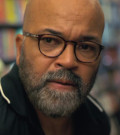
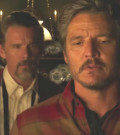
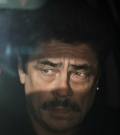
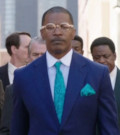
Comments: